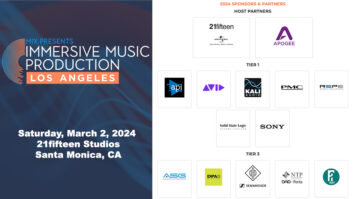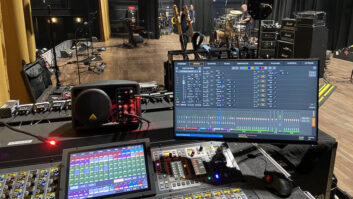Next month is the two-year anniversary of “Tech’s Files” and, if much of your reading happens (like mine does) in the porcelain office, both your behind and mine are behind. What follows is a quick overview of past articles in case you missed ’em or wanna see the follow-up. Most are available online at www.mixonline.com (sans pix—check the “Browse back issues” link on the left) and at www.tangible-technology.com, where, if you don’t see what you’re looking for, just ask.
IN THE BEGINNING
In April 2000, the very first “Tech’s Files” was about DAT machines. By the fourth month of the following year, four more installments of “This Old Tape Machine” appeared. From generic tape tips to DTRS and ADAT specifics, more is covered here in Mix than in any other magazine. Be they rotating or stationary, heads endure miles of tape being dragged across them. Tape leaves its mark on guide flanges, capstan shafts and pinch rollers, all while removing material from head surfaces. I always emphasize the need to check the error rate and am no longer surprised to learn how often users ignore error messages.
DO HIGH-PERFORMANCE CABLES REALLY MAKE A DIFFERENCE?
In May 2000, I tweaked the electro-mechanical impedance of a tweeter using Ferrofluid, and, though not designed for it, the bird is still singing. Ferrofluid, a mix of magnetically conductive material combined with an application-specific fluid, improves efficiency and extends life expectancy by allowing heat transfer from voice coil to the magnet structure.
Far more challenging was my attempt at making impedance more tangible in 2001. My brain cells still burn from the experience; perhaps someone has since invented a cranium-specific cooling solution. The essence of the lesson was to explain the role impedance plays when interfacing gear. If a device with a source (output) impedance of 1,000 ohms or greater is coupled to a device with a bridging (high-impedance) input using a high-capacitance and/or extremely long cable, then the high-frequency response will suffer. Look for cables with low-capacitance-per-foot values. The typical maximum acceptable value should not exceed 50 pico-Farads (pF); good is 35 pF, and better is below 20 pF. Investigate before you buy.
Note: The 600-ohm transformer technology found in older gear expects input and output impedances to match, resulting in what is known as “Maximum Power Transfer.” MPT is not the most efficient from a voltage perspective — the signal is cut in half — but it minimizes the effect of cable on high-frequency response.
Bottom line? Line- and mic-level gear that needs special cable is poorly designed unless your application is remote recording. For power amps and speakers, heavier-gauge cable compensates for greater distances between them.
JULY 2000: THE NATIVES ARE RESTLESS
Two hot topics in the middle of the summer — sound cards (2000) and guitar noises (2001). This time last year, as if they were reading my mind (or perhaps this column), Mackie Designs purchased SYDEC, the Belgian company that created the Soundscape workstation — my workstation. I often felt Soundscape was underappreciated and had suggested partnership to several American companies. While many products are still in diapers when brought to market, Mackie and its customers will benefit by embracing Soundscape’s mature technology.
PARTNERS SUBLIME
An e-mailed press release has just arrived announcing another Mackie partnership, this time with Universal Audio, whose Powered Plug-Ins — DSP hardware with the most authentic digital versions of LA-2 and 1176 compressor/limiters, plus great EQ and reverb — will now be marketed and distributed by Mackie.
At the 2000 NAMM show, I nudged Bill Putnam to consider creating plug-in versions of his Universal Audio product line. Several conversations later, the lightbulb came on. The essence of any vintage analog device is the sum of its parts. This includes input and output transformers, their respective amplifiers, as well as the actual gain reduction and EQ circuitry. Such DSP-intensive emultation would never really fly as a multi-instance Native plug-in, but Universal’s custom card can do justice to these exalted vintage products and your ears, while minimizing host processor overhead. (I’ve heard the preview, and I think you’ll really like it! I hope future versions will include the isolated components so users can roll their own.)
Mackie’s two “partnerships” indicate a trend back to dedicated hardware — a solution for Native workstation users who find that they are always pushing the envelope. The technology and the power are here now with options for everyone.
AUGUST-OCTOBER 2000: ANALOG TAPE MACHINES 101
Starting in August 2000, the analog tape machine series stretched across three issues, striking major chords with readers. It’s not just about hot-rodded half-inch or 1-inch stereo machines, but the many pro and semi-pro formats sitting in dark corners getting occasional use. Will you be ready when a client walks in and is willing to spring for a reel of tape? And what tape to use? Do you know how to align?
Most machines originally designed for Ampex (Quantegy) 456 and 3M 250 should still be using that type of tape, now available as EMTEC 911. Older machines may not be capable of erasing super-high-output formulations such as Quantegy 996, GP9 and Emtec 900. Those machines that have the right stuff really should be re-tensioned for the newer formulations to avoid the risk of accelerated head wear.
A newly lapped head needs minimal tension, so make sure you’re not wasting this valuable and precious resource.
Speaking of the Tartan Mining and Manufacturing Company from Minnesota, 3M tape machine parts are becoming quite scarce — I quickly sold my last pair of capstan belts via e-mail to one desperate user. For all vintage machines, keep a close eye on pinch rollers and other rubber parts that can get gummy with age. Clean after a session rather than before to remove tape chemicals that can degrade the rubber material while you sleep. Don’t clean with just any “designated” rubber cleaner; use only “the pink stuff” sold by www.athan.com. (In a pinch, use Windex, Fantastic or Formula 409.)
NOVEMBER 2000: LA-4/RC4136 UPGRADE OPTIONS
Over a year ago, I experimented with upgrading the quad op amps in the UREI LA-4A optical limiter. Not everything old is great, and the RC4136 amplifiers in that unit get cranky when hit with too much level. Thanks to Dan Kennedy at Great River, a plug-in IC retrofit kit is now available. UREI was kind enough to include sockets, so depending on your skill level, the first step to improving the signal path can be as simple as swapping chips — or review the original article online to see the expanded upgrade path options. Drop me an e-mail for more info or to let me know of other products that use the RC4136.
Also that month, the “maintenance and upgrades” series began with tips for locating bad electrolytic capacitors (via square waves and oscilloscope), plus op amp power and performance issues. At the time, Panasonic HFS and HFQ Series caps were the recommended replacements, but these have been discontinued and replaced by the FC Series. Readers recommended alternatives such as the Sanyo “Os-Con” and Elna “Starget” caps; all are better than many of the original factory parts.
There are many opinions about IC op amp sonics, but “fastest is bestest” may not always be the best strategy. Faster could mean higher current demands, not an option if the power supply lacks headroom — most just barely deliver the goods. The combination of speed and current can cause some circuit designs and/or PCB layouts to oscillate, either constantly or at the clipping point, potentially frying ears and tweeters. If you must drive a hot rod, then invest in an oscilloscope and/or a geek who knows how to use one. Don’t be greedy.
MAY 2001: A BALANCING ACT
One recurring life theme is having the tenacity to follow a process all the way through to the end, no matter how daunting. Many of us are forced to own multiple hats — production, engineering and technical — but only one can be worn at any time. Knowing when it’s time to take a break will help you regain perspective on an arrangement, a mix or finding the source of an intermittent. Patience is key. So is a clear head.
AUGUST 2001: DTRS TIPS & TRAPS
Tascam’s DTRS format was most recently visited in August with step-by-step instructions to access the Error Rate display.
Recent stump-the-tech issues included an ancient DA-88 that I rebuilt, only to receive frustrated calls about intermittent high error rate. Yes, it happens to me too. The cause? After swapping heads and cards, the problem was traced to a pinched, shielded cable between the record amplifier and the DSP card. I lost money on the deal, but now know to check that cables will not get trapped between the SY-88 (sync) card and the momma board.
DECEMBER 2001: ADAT BONDAGE, MASTER LINKS
“ADATs that don’t like to slave” is a burning issue from the Twin Cities to South Africa. If only one machine exhibits this problem, make it the master as a temp fix. While Alesis was restructuring this time last year, many service geeks became increasingly more reliant on each other. Marc Lewis of McCann Electronics in Louisiana compiled an e-mail list of service centers, and Paul Plotnick at Pro Digital in Philadelphia found that a hard reset fixes the problem. This is not a user-serviceable problem, but your local repair facility has the necessary tools.
Several readers e-mailed questions about the Alesis Masterlink “Power Tools” article. Use 5,400 rpm drives only! By the time you read this, I should finally have additional info posted at tangible-technology.com about modifications that include an external drive with removeable caddy plus a multi-drive selector. The goal was to provide maximum flexibility for those who work on multiple projects, enabling each project to live on its own drive.
FEBRUARY 2002: TRUE COLORS
Last month, while writing about computer tweaks hard and soft, I simultaneously set up a new system for a neighbor. The PC was hardware-endowed, but software-light, shipping with only the Windows XP operating system. I popped in a DVD of The Corrs’ In Blue featuring 5.1 surround mixes of their album plus a video of the single “Breathless.” The first glitch should have been the clue; the video didn’t play but its audio did. The Beatles’ Yellow Submarine behaved as intended.
I downloaded a few odds and ends via cable modem to make sure the other peripherals were functional. Roxio has a 90-day trial version of CD Creator that, while quirky, allowed the CD-R to be tested. I’m not sure if the problem was hardware or software, but I kept getting errors that the recording media was flawed. It wasn’t. Adobe’s Photo Deluxe first complained about insufficient virtual memory — the PC was loaded with a half-gig of RAM, 80 and 20 GB of rotating storage. I eventually got everything to work. Once the PC was in its new home, the neighbors had not yet sprung for cable-modem service, so they loaded AOL only to find that a new XP-compatible download was necessary — two hours at 28.8 kbps!
XP has sexy multi-user capabilities, each with their own level of permissiveness. Basically, users can tweak their desktop, preferences and favorites while administrators can install and remove programs. Not all programs have “caught up” to XP. That should be no surprise. XP hasn’t caught up to XP as exemplified by The Corrs’ DVD on Microsoft’s own Media Player. Adobe Photo Deluxe is another example. I installed it as an administrator, but it wouldn’t run for any user without administrative privileges (which kinda defeats the purpose). Click on the icon, get a momentary hourglass and then nothing. Where’s artificial intelligence when you need it?
While all of this may seem irrelevant to Mix readers, it’s not. These are super-basic issues that should already have been resolved. Too often, we chase our tails trying to get audio applications to work correctly. We all await the next wave of enlightenment when operating systems and applications can self-diagnose with the ability to at least point us in the right direction. What’s the moral of the story? Ask the software company what operating system is best for its application. Be sure to regularly check for updates. If you haven’t yet done so, get high-speed Internet access via cable or DSL.
BUYER BE WHERE?
The most common issue reported by users and readers concerns used equipment purchases. For modular multitracks, no matter what the reported hours are, always factor in the head replacement cost (about $850), then compare the “adjusted deal price” to that of a new machine. Think about how you might sell a piece of gear — everyone wants to get top dollar for a minimum investment. If maintenance costs put new and used gear on nearly level ground, then the choice is easy. The additional knowledge will give you the leverage to negotiate a fair price.
For more links and tips, visit Eddie Ciletti at www.tangible-technology.com and see if he ever got around to posting pix of his second child.







